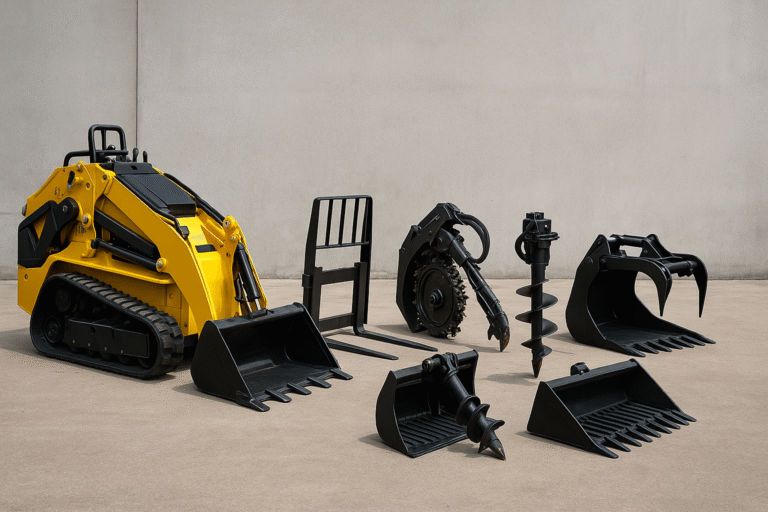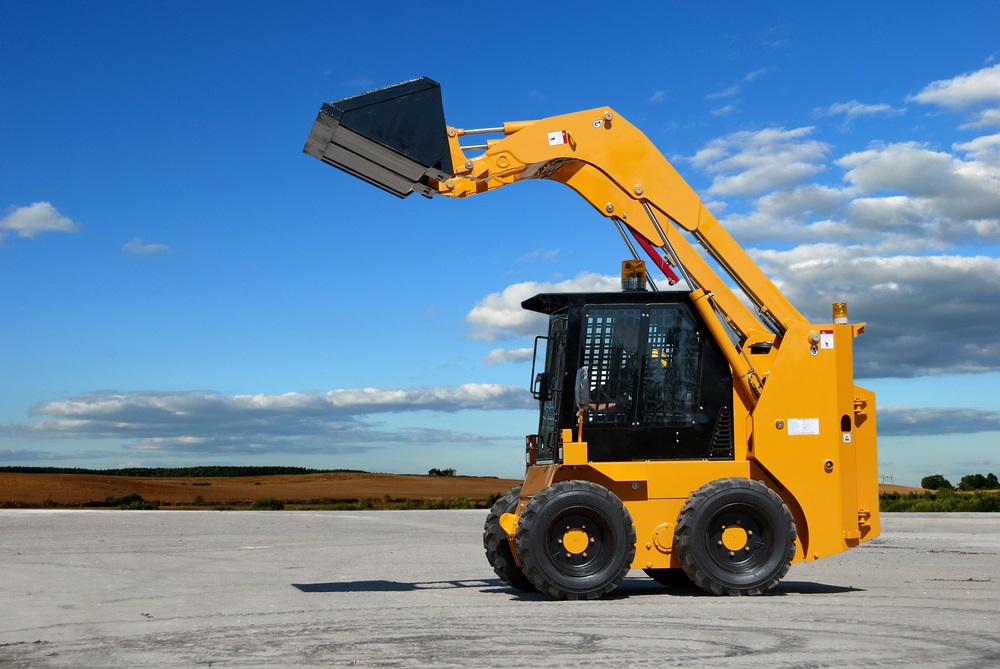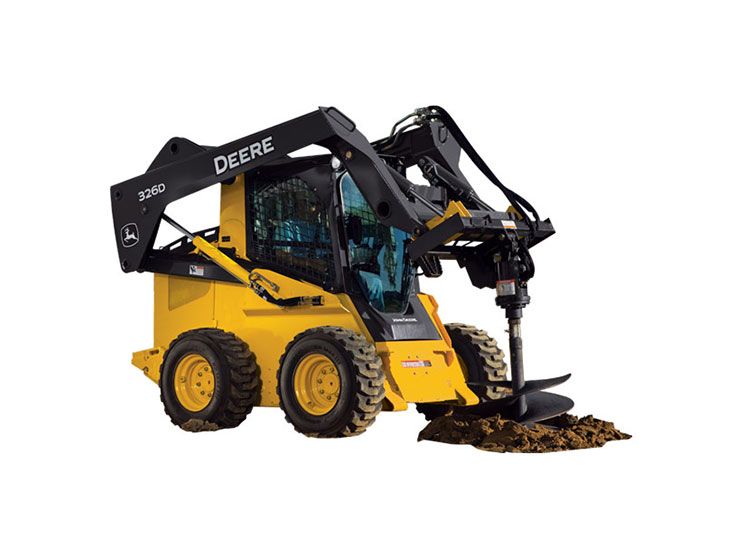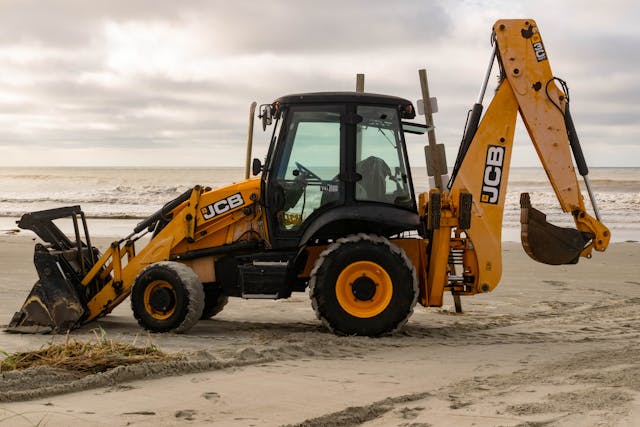One of the major factors that make mini skid steers so attractive and loved by customers is their capability to change into a multi-use device with the suitable accessories. In case you have a machine, it is not necessary to purchase different pieces of equipment for digging, lifting, or grading. You only need to interchange the attachments and keep going. What if we skim through the basic mini skid steer attachments that could work wonders with your investment?
1. Buckets
Buckets are the most common attachments, and they come in different styles depending on the job.
- Standard dirt buckets are just right for moving soil, gravel, and mulch.
- Grapple buckets have a hydraulic claw that can grab logs, brush, and debris.
- 4-in-1 buckets make it possible to use one tool for dozing, grading, and dumping.
The use of your skid steer in landscaping, construction, and cleanup jobs is what the right bucket will determine.
2. Augers
Auger attachments can drill holes in a very short time and in a proper manner. If you are installing fence posts, planting trees, or setting poles, then augers are the ones to save you from the hassle of hours of manual work. They are available in varying diameters, hence you can pick out the one that matches your project requirements.
3. Trenchers
Basically, work that requires running irrigation lines, electrical conduits, or drainage systems is the one that will definitely need a trencher attachment. It digs narrow, clean trenches at a pace that is almost double when compared to manual digging, thus landscaping workers and contractors can accomplish a lot in lesser time with this aid.
4. Pallet Forks
Transform your mini skid steer into a forklift with pallet forks. This is the best attachment that could be used to make it easier the job of transporting pallets, lumber, or heavy building materials on a site. For small contractors and farm owners, pallet forks not only can save time but also can reduce the need for more equipment.
5. Landscaping Attachments
Mini skid steers have been overwelmingly successful in landscaping, and there is a plethora of different tools for the job.
- Soil conditioners for smoothing and prepping soil.
- Rakes for removing debris.
- Sod rollers for turf laying.
These attachments allow landscapers to finish their work quicker while providing a professional finish to the client.
6. Snow Removal Tools
In case you are residing in a freezing area, the skid steer can be your snow removal machine as well. Snow blowers, snow pushers, and snow blades are some of the attachments that easily enable you to clear the driveway, sidewalk, and parking spaces during winter.
Basically, the correct attachments convert your skid steer into an all-season powerhouse, be it a summer dig or a winter snow push. When considering a mini skid steer for sale, always take into account which attachments you will be needing the most for your work.
Maintenance Tips for Mini Skid Steers
Purchasing a mini skid steer is a significant investment, and just like any vehicle, it takes some maintenance from time to time to keep it running smoothly. Beside the longer lifespan, the well-kept skid will also save your money, since it will prevent you from paying for expensive breakdowns.
1. Perform Daily Inspections
Each day before starting your work, take a short walk around the place where the machine is and check it visually. Look for:
- Leak of fluids (Oil, hydraulic, and coolant).
- Hoses and fittings that are loose or damaged.
- Tracks or tyres that are worn-out.
- During the starting up, if there are any strange noises or vibrations.
When you spot a problem in its earliest days, the big repair work that comes next will be avoided.
2. Keep Fluids in Check
Mini skid steer hydraulic systems are, in fact, the most important parts of the whole machine, so the fluid level in them is to be closely monitored. Besides oil, coolant, and fuel, the level should also be in the range recommended. Oil or hydraulic fluid made of the wrong material can lead to the premature wearing of parts, so always stick to the manufacturer instructions.
3. Clean Air Filters Regularly
Filters can get clogged quickly with dust and other particles if you are working with construction or landscaping. In order to avoid engine strain and slowdown of efficiency, air filters should be cleaned or replaced on time.
4. Maintain Tracks or Tires
- Tracks of the skid steers that have a track should, always, come with the checking for proper tension and the inspection for the rips.
- Skids with wheel need to have the tire that is properly inflated and be checked for any cuts or penetrations.
Tracks or tires that are less than perfectly maintained not only have less hold but also wear the machine at a faster rate.
5. Schedule Routine Servicing
Start following your brand’s suggested service intervals that include oil changes, hydraulic filter replacements, and servicing. Normally, most contractors schedule servicing every 250 working hours. By chasing up with these intervals, you are basically assuring that your machine will be in its prime condition.
6. Store Properly
If you are not going to use your skid steer, then it is better to keep it in a dry and covered place. Any exposure to the elements can lead to rust, hydraulic issues, and premature wear.
If a mini skid steer is adequately maintained, it can be used for 3,000–5,000 hours or more. Therefore, a good maintenance routine is the best way to get the most out of your money.
Safety Tips When Operating a Mini Skid Steer
Mini skid steers by no means are small or weak comparing to full-size machines, but on the other hand, they still have the same power as the latter. The improper operation of the machine can result in accidents, which in turn can cause injuries or expensive damage. Whether you are a long-time contractor or a new user, safety should always be the number one priority.
1. Get Proper Training
Don’t put down the importance of the learning curve. While mini skid steers are less complicated compared to larger equipment, operators ought to have their basic training set. There are some states where one has to be certified before starting professional work.
2. Wear Safety Gear
Operators must always put on:
- A safety helmet.
- Shoes with steel toes.
- Protective goggles.
- Ear protectors.
Moreover, if the work is carried out in an area with a lot of traffic, one’s high-visibility clothing becomes a must-have item.
3. Know Your Surroundings
The hazards to be looked for before work commencement include overhead wires, ground that is not even, or utilities underground. The stability of mini skid steers is guaranteed, but if they are operated recklessly on the slope or on the unstable ground, tipping may occur.
4. Follow Load Limits
Each mini skid steer is designed with a rated operating capacity (ROC). Apart from the risk of tipping, overloading will also cause the hydraulic system to overheat and shorten the machine’s lifespan. Loading capacity written in the operator’s manual is the one that should always be followed.
5. Practice Safe Operation
- Don’t let people who are not involved in the job stand close to the work area.
- By default, the bucket or attachment should always be at its lowest position when the machine is at rest.
- Do not make a sudden move when you are lifting heavy objects.
- If your model has seat belts or safety bars, then you must use them.
When you follow these rules, you’ll not only minimize the chances of an accident and ensure that your operations run smoothly and safely. A mini skid steer is a great asset just like any other strong equipment it must be handled in a proper and safe way.
Future Trends: The Evolution of Mini Skid Steers
The mini skid steer market is changing rapidly with new technologies that are making the machines smarter, more environmentally friendly, and more efficient. If you are considering purchasing a mini skid steer for sale, it is really good to know how everything is unfolding in the industry.
1. Rise of Electric Models
As the world is focusing more on going green, the manufacturers are coming up with electric-powered skid steers. These machines are quieter, do not emit any harmful gases, and thus are perfect for indoor or urban projects where noise and pollution are big problems. The electric models presently are more expensive, but the prices are expected to come down as the technology gets better.
2. Smarter Technology
More and more portable tech-enabled skid steers, owners can monitor the machine’s performance through that tracking maintenance and location routine by an app. It is useful as it helps the contractor save valuable time and also his operating costs.
3. Improved Attachments
Producers are continuously coming up with more specialized attachments for mini skid steers which in turn converts them into highly versatile machines. Some of that future trenching may come straight from the factory with deeply programmed trenching tool and automated grading.
4. Focus on Operator Comfort
Moreover, the comfort of the driver is a major concern even for small machines. The features like suspension, ergonomic usage of controls, and better visibility have been added to the new models and the aim is to prolong the operators’ session and increase the work efficiency.
5. Increased Demand in Urban Construction
As cities are growing, the demand for smaller machines such as mini skid steers is going to increase proportionally. The contractors who work in the narrow areas of the cities can make great use of these machines and that would push more innovations to be made regarding the size, power, and maneuverability of the machines.
Mini skid steer chang the future aspect appears to bright and those buyers that make the right equipment investment today will feel these advancements in the future.
Conclusion: Finding the Right Mini Skid Steer for Your Needs
A mini skid steer is not just a item to be bought – it is an investment in efficiency. A contractor, landscaper, farmer, or homeowner—you name it—these small machines provide the same benefits in terms of versatility, power, and convenience as those of larger equipment, which, however, cannot reach or match.
In our previous articles, we have gone virtually through all the brands and types, the pricing and financing, the attachments, as well as the maintenance operations. The point at issue, however, is to go through your requirements thoroughly before deciding. You are advised to carefully weigh up your work load, available budget, and condition of the job site and then opt for a machine which balances performance and price.
And don’t forget that the best mini skid steer for sale is not always the priciest—it is the one that suits your tasks, facilitates your work, and makes your enterprise prosper.
FAQs
1. What is the average lifespan of a mini skid steer?
If a mini skid steer is well-maintained, it can be used for roughly 3,000 to 5,000 hours. A few premium models can even outlast this range.
2. How much horsepower does a mini skid steer have?
The power of a mini skid steer can be anywhere between 20 and 40 horsepower. The exact value depends on the model and the brand.
3. Can mini skid steers handle heavy construction work?
These machines are great for light or medium works such as landscaping, trenching, and material handling. A full-sized skid steer is necessary, if the load is too heavy.
4. What are the most affordable brands of mini skid steers?
Toro and Kubota are known to offer some of the most affordable mini skid steer models with a decent performance.
5. Are attachments universal across brands?
Not quite. The majority of brand-specific attachments also apply to different models, but a few brands have secretive mount systems, so make sure to verify before you buy.

